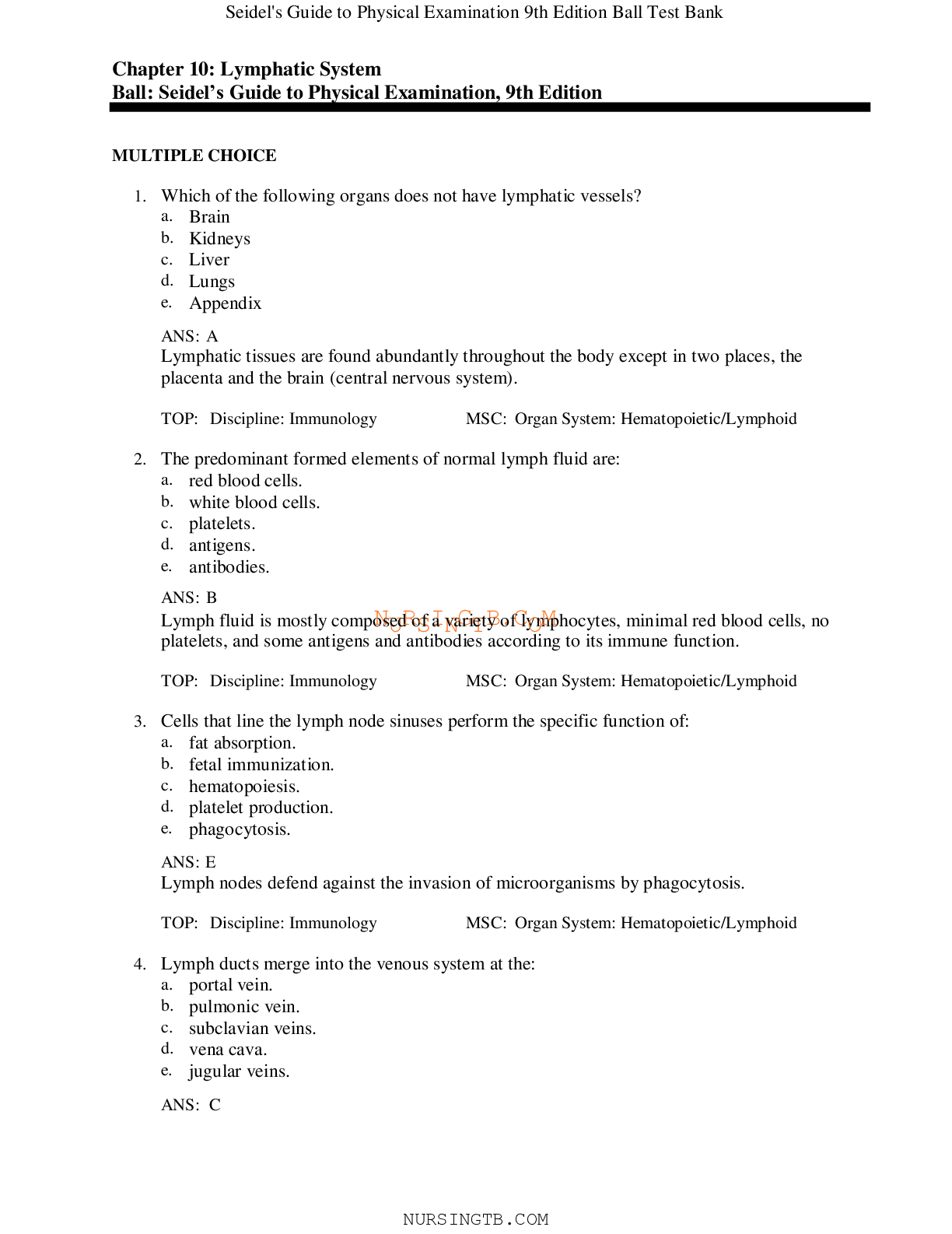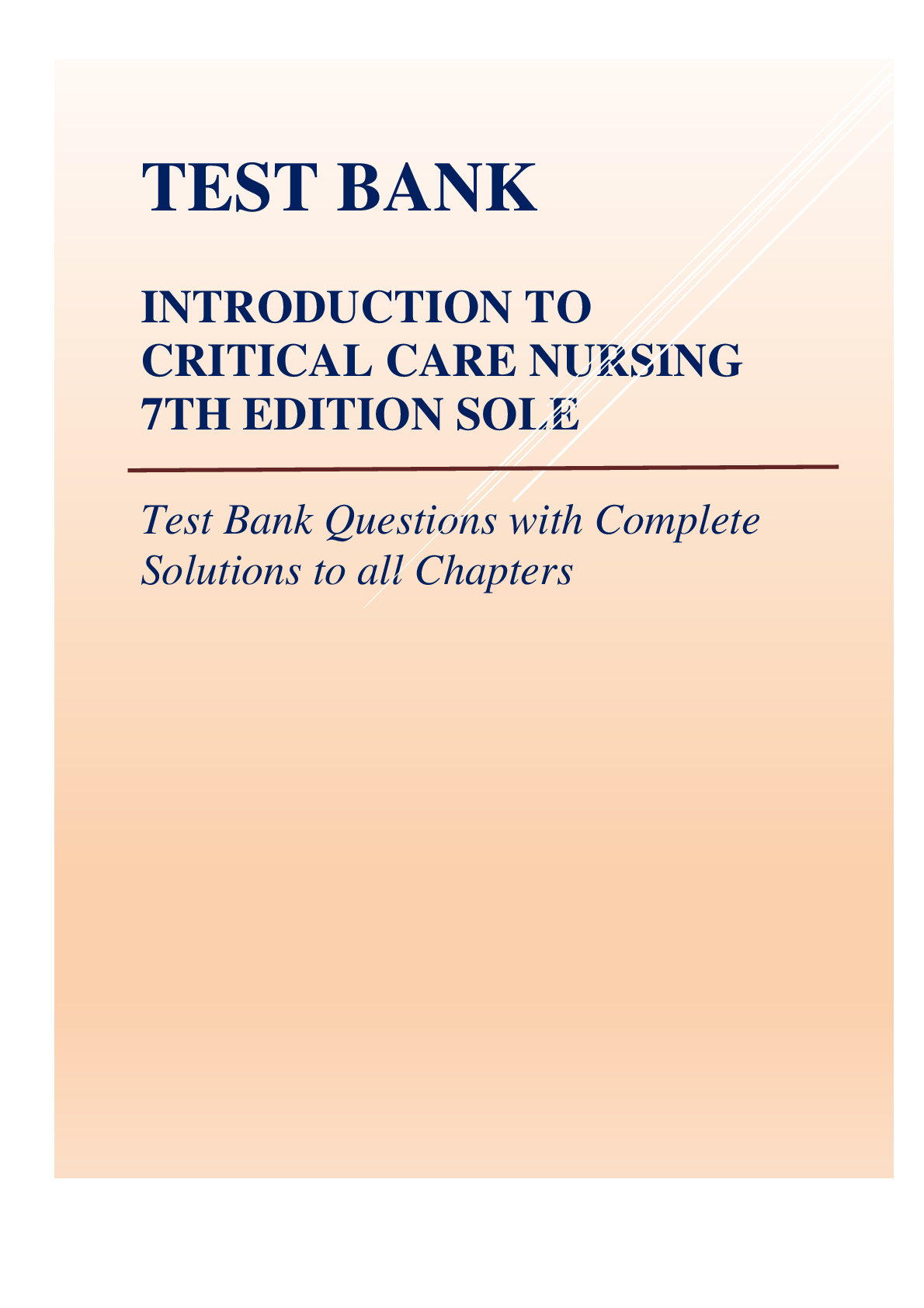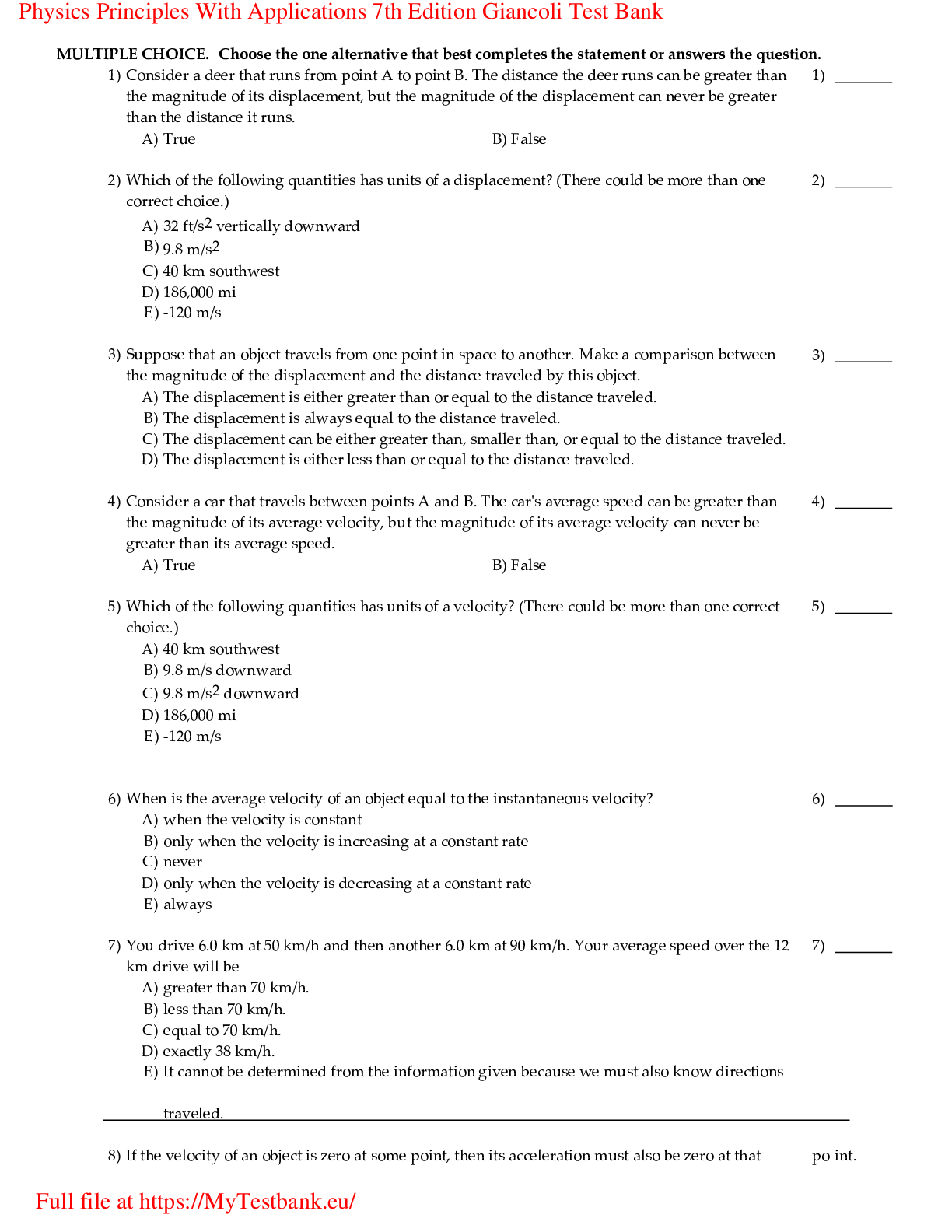*NURSING > TEST BANK > PANCE Practice Exam #3. Test bank questions with accurate answers, 2022. Rated A+ (All)
PANCE Practice Exam #3. Test bank questions with accurate answers, 2022. Rated A+
Document Content and Description Below
PANCE Practice Exam #3. Test bank questions with accurate answers, 2022. Rated A+ cornea steamy, and the pupil moderately dilated and nonreactive to light. - ✔✔acute bacterial conjunctiviti... s A 3-week-old male infant is brought in by his mother due to his vomiting. The mother notes that a few days ago her son started vomiting after feeding, and it has become projectile in nature. The vomitus is non-bilious and contains no blood. The child seems hungry and nurses regularly, but the vomiting has become more frequent and is occurring with every feeding now. On physical examination, an oval mass is palpated in the right upper quadrant. What laboratory finding is most consistent with the suspected diagnosis? A. Decreased hematocrit B. Elevated amylase C. Hyperkalemia D. Hypochloremic alkalosis - ✔✔The answer is D. Laboratory findings that are consistent with the suspected diagnosis of pyloric stenosis include hypochloremic alkalosis with potassium depletion. An elevated hemoglobin and hematocrit can also be present, and are due to dehydration. Changes in amylase or serum sodium are not present in cases of pyloric stenosis. A 39-year-old man presents to the emergency department with massive hematemesis. His physical examination reveals slight jaundice, palmar erythema, spider angiomas, and marked ascites. Vitals at the time of presentation are as follows: BP: 85/44 mm Hg, P: 122/min, R: 16/min, oxygen saturation: 96%, and T: 99.8°F. Which of the following is the most likely cause of the massive hematemesis? A. Peptic ulcer disease B. Mallory-Weiss tear C. Gastric carcinoma D. Arteriovenous malformation E. Esophageal varices - ✔✔The answer is E. EXPLANATION: The most common cause of massive upper gastrointestinal bleeding in patients with cirrhosis is esophageal varices. Although 20% of patients with portal hypertension will have bleeding from other causes (peptic ulcer disease, Mallory-Weiss tears, or gastritis), endoscopic evaluation in patients with portal hypertension is necessary for diagnosis and initial therapy. A two-month-old bottle fed infant female presents with a sharply demarcated scaling red rash on the face and in the diaper area. The mother reports that her child has been irritable and has had diarrhea. The primary care provider has treated with hydrocortisone 2.5% ointment bid for two weeks with no improvement. What should be the next step in confirming the diagnosis? A. punch biopsy at border of genital rash B. bacterial culture and viral culture C. KOH and bacterial culture D. cbc with diff and Zn level - ✔✔The answer is D. EXPLANATION: This infant is displaying classic signs of zinc deficiency. This disorder can occur in infants who are bottle fed. Treatment with topical steroids will not improve the condition until the zinc level is corrected. A punch biopsy would not help in diagnosing the zinc deficiency that this patient is exhibiting. Bacterial and viral cultures will not be helpful in establishing the diagnosis. A KOH is used to diagnose fungal infections. The KOH and bacterial culture will not be helpful in establishing the diagnosis of zinc deficiency. A 56-year-old male is diagnosed with an H. pylori associated ulcer. The ulcer was 0.8 mm in size on endoscopy. He is placed on a proton pump inhibitor, clarithromycin, and amoxicillin. If his dyspeptic symptoms resolve after starting this regimen, how many days should he take the proton pump inhibitor to complete the treatment? A. 5 to 7 days B. 10 to 14 days C. 14 to 21 days - ✔✔The answer is B. EXPLANATION: In an H. pylori associated ulcer that is < 1cm in size and dyspeptic symptoms resolve with therapy, 10 to 14 days is the recommended length of treatment. For patients with large or complicated ulcers, antisecretory therapy should be continued for an addition two to four weeks (duodenal ulcer) or four to six weeks (gastric ulcer) after completion of the antibiotic regimen. A 26-year-old woman has decreased appetite, weight gain, cold intolerance, hoarse voice, constipation, and arthralgias. What is the most likely etiology of her condition? A. autoimmune thyroiditis B. congenital hypothyroidism C. dietary iodine deficiency D. surgical resection of the thyroid gland - ✔✔The answer is A. EXPLANATION: Auto immune thyroiditis is the most common cause of hypothyroidism in the United States. Dietary iodine deficiency is the most common cause in underdeveloped regions of the world. A patient is recovering from having a total thyroidectomy two days ago for medullary thyroid cancer. An extensive neck dissection was required during the surgery. Post-operative lab testing reveals a low serum calcium level. Which of the following clinical presentations will most likely occur in this patient? A. Constipation B. Anorexia C. Polyuria D. Bone pain E. Paresthesias - ✔✔The answer is E. The correct choice is E, paresthesias. Circumoral paresthesias are signs of hypocalcemia. Hypocalcemia can occur after any type of neck surgery that may have resulted in destruction of the parathyroid glands. Choices A through D are symptoms of hypercalcemia and may be seen in hyperparathyroidism. A 51-year-old male patient presents to your family practice office complaining of genital discomfort with dysuria. His digital rectal exam reveals an enlarged, tender prostate. His prostate-specific antigen (PSA) returns elevated with a value of 11.1 mg/mL, which you fractionate, and this reveals approximately 75% free PSA. His urinalysis reveals moderate white cells and trace blood. What would be your next step in treating this patient? A. Begin him on 6 weeks of doxycycline to treat his prostatitis and when resolved, repeat his PSA level. B. Immediately refer him to a urologist for prostate biopsy to rule out prostate cancer. C. Immediately refer him to a urologist for cystoscopy to rule out bladder cancer and perform a computed tomography (CT) scan of the abdomen and pelvis in the interim. - ✔✔The answer is A. EXPLANATION: This patient has signs and symptoms consistent with prostatitis. Additionally, while his PSA is elevated, this is common in prostatits as well as prostate cancer, and his free PSA is of a percentage that prostate cancer is unlikely. However, it would be prudent to recheck his PSA after treatment and resolution of his symptoms to confirm that an underlying cancer is not smoldering. A 52-year-old female with a past medical history of dyslipidemia, GERD, hypothyroidism, and osteoarthritis presents with a gradual progression of fatigue and pallor over the last few months. Initial CBC results show a hemoglobin of 10.7 mg/dL, hematocrit of 33%, an MCV of 117 fL, and a reticulocyte count of 0.0%. Which of the following medications should be considered as a potential cause of her anemia? A. Celecoxib B. Cholestyramine C. Levothyroxine D. Omeprazole E. Ranitidine - ✔✔The answer is B. EXPLANATION: Cholestyramine is associated with folate malabsorption and may rarely be a medication cause for macrocytic anemia. A 36-year-old male returns to the office for follow up of his heartburn symptoms. He continues to have heartburn three to four times a week, even though he has been compliant with his proton pump inhibitor medication since it was prescribed three months ago. He underwent an endoscopy three weeks ago, which was normal. He denies dysphagia, early satiety, or weight loss. Which of the following tests is the most appropriate next step in evaluating this patient? A. Repeat endoscopy B. Barium esophagography C. Esophageal manometry D. Abdominal CT scan E. Urea breath test - ✔✔The answer is C. EXPLANATION: Esophageal monometry is the answer, and this is useful in patients who have persistent symptoms, despite PPI therapy and individuals who have had normal findings on endoscopy. There is no reason to repeat the endoscopy, as the first one was normal. Barium esophagography plays a limited role in GERD, and could be helpful if the patient complained of dysphagia. Abdominal CT is not indicated in this case. Urea breath test is used in the detection of H. pylori, which is an uncommon cause of dyspepsia in the absence of peptic ulcer disease. A 77-year-old female has been treated for the last two weeks for a community-acquired pneumonia. While on oral azithromycin, the patient continues to develop fevers, some as high as 1030F. Her oral intake has decreased, and her effort to breathe continues to be labored. On examination, the patient continues to have rhonchi and some mild rales that are best appreciated in the anterior right lung region. A follow-up chest x-ray reveals a consolidated infiltrate of the right middle lobe. A CT of the chest reveals a loculated, fluid-filled area of the right middle lobe with no evidence of a foreign body. Based on these new findings, what is the most likely pathogen causing this ongoing infection? A. Staphylococcal aureus B. Pseudomonas aeurginosa C. Hemophilus influenza D. Klebsiella pneumoniae - ✔✔The answer is A. EXPLANATION: This patient is having a history and physical exam that is consistent with an empyema. This loculated collection of fluid will harbor bacteria, the most common pathogen being Staphylococcus aureus. Intravenous antibiotics as well as surgical drainage are warranted. A CT of the chest reveals a loculated, fluid-filled area of the right middle lobe with no evidence of a foreign body. Based on these new findings, what is the most likely dx? - ✔✔Empyema- This loculated collection of fluid will harbor bacteria, the most common pathogen being Staphylococcus aureus. A 18 year-old man present to the clinic due to a recent positive tuberculosis screening test. Which of the following steps should be taken to avoid neurotoxicity associated with his prophylactic isoniazid (INH) treatment? A. Perform an initial screening mental status exam B. Supplement with folic acid C. Supplement with pyridoxine (vitamin B6) - ✔✔The answer is C. EXPLANATION: INH leads to the development of peripheral neuropathy in 2% of patients secondary to pyridoxine deficiency. This can be prevented through the coadministration of pyridoxine (vitamin B6) Which of the following is most useful in diagnosing renal artery stenosis? A. magnetic resonance angiography (MRA) B. computed tomography (CT) scanning C. captopril renal scan D. renal artery biopsy - ✔✔The answer is A. EXPLANATION: Magnetic resonance angiography, enhanced with gadolinium, is 99% to 100% sensitive and 71% to 96% specific for diagnosing renal artery stenosis (RAS). This study has largely replaced the captopril renal scan and contrast-enhanced arteriography in diagnosing RAS. The principle behind the captopril renal scan is that ACE inhibitors lower GFR. In a kidney with already-compromised blood flow due to RAS, administration of the ACE inhibitor further decreases GFR in the affected kidney despite maintenance of adequate plasma volume. GFR in the contralateral kidney remains normal. Subsequent injection of a radionuclide reveals delayed uptake in the compromised kidney. Although arteriography provides the most definitive diagnosis, it carries its own risks of contrast-induced injury and bleeding. MRA is a low-risk procedure due to its noninvasive nature. Renal artery biopsy would not yield this diagnosis. IVP is utilized to visualize the anatomical structure of the urinary tract in situations such as urinary tract trauma and outflow obstruction, although increasingly it too is being replaced by noninvasive testing, such as ultrasound, CT scanning, and MRI. It remains a useful test to pinpoint the location of a calculus in the urinary tract. Which drug can potentially lead to oropharyngeal candidiasis, and which agent can be used to treat this type of infection? A. albuterol; ketoconazole B. triamcinolone; fluconazole C. fluticasone; amantadine D. cromolyn sodium; levofloxacin - ✔✔The answer is B. EXPLANATION: If they coat the mouth and throat, inhaled corticosteroids (eg, triamcinolone, fluticasone, flunisolide) can alter the local bacteria and fungal population, thereby enhancing fungal growth. In cases of oropharyngeal candidiasis (thrush), white spots on the tongue and hard palate can be visualized, and the patient usually has pain on swallowing. In the asthma patient, the utilization of a spacer with a metered dose inhaler (MDI) can help minimize the chances of oropharyngeal candidiasis, as can routine gargling and rinsing following each inhaled treatment. Fluconazole is an antifungal agent that is effective in treating oropharyngeal candidiasis. What is the definitive treatment for the majority of patients presenting with mild symptoms of hyperthyroidism secondary to subacute thyroiditis? A. Subtotal thyroidectomy B. Oral methimazole C. Symptomatic treatment D. Radioactive iodine E. Antibiotics - ✔✔The answer is C. The correct choice is C, symptomatic treatment. Most patients with subacute thyroiditis and symptoms of hyperthyroidism require only symptomatic treatment, with non-steroidal anti-inflammatory medications and/or beta blockers, for any cardiac symptoms including palpitations and tachycardia. Occasionally, patients may require a course of prednisone for this acute inflammatory condition. Most patients will recover spontaneously within a few months. Choices A, B, D, and E are not necessary in this condition. Most cases of subacute thyroiditis are associated with viral infections, and resolve without additional thyroid medications. A patient is brought to the Emergency Department by ambulance. He is a 27-year-old male who is well known to the paramedic team as a heroin addict. He is arousable and does not remain alert when aroused. Which of the following physical signs would help to confirm the diagnosis of opioid intoxication? A. Bradycardia B. Diaphoresis C. Mydriasis D. Rhinorrhea E. Tachypnea - ✔✔The answer is A. EXPLANATION: Bradycardia (A), lowered respiratory rate, miosis and somnolence are the main effects of opiates. As with most medications, withdrawal effects are the opposite of the effects of overdose. Tachycardia, tachypnea, rhinorrhea and diaphoresis (B, D, & E) can all occur in opiate withdrawal. Mydriasis (C) is common with other substances of abuse, such as cocaine and LSD. dilated pupils - ✔✔Mydriasis constricted pupils - ✔✔miosis common with other substances of abuse, such as cocaine and LSD. - ✔✔Mydriasis opioid intoxication sx - ✔✔Bradycardia , lowered respiratory rate, miosis, somnolence are the main effects of opiates. peripheral neuropathy s/e - ✔✔INH You are providing care to a woman who is at 33 weeks gestation. Her pregnancy is complicated by gestational diabetes. She is being provided education by the dietician, and has weekly obstetrical appointments. What fasting blood sugar (FBS) readings should necessitate switching from diet control to insulin therapy? A. FBS > 70 mg/dL B. FBS > 90 mg/dL C. FBS > 95 mg/dL - ✔✔The answer is C. EXPLANATION: Gestational diabetes has different risks associated with it, in particular for the fetus. Stricter glycemic controls are recommended for pregnant versus non pregnant women by the ACOG and the ADA. A 29-year-old female has a long history of supraventricular tachycardia, for which she has been treated with long-term flecanide, as well as prior therapy with verapamil. She continues to have repeated episodes, sometimes two to three times a week, along with shortness of breath and at times hypotension that has been recorded. What is the next best therapy for this patient? A.Synchronized cardioversion B. Cardiac catheterization C. Ablation therapy - ✔✔The answer is C. EXPLANATION: After exhaustion of non-invasive therapies, ablation therapy can be used to try to negate the aberrant pathway for SVT. Pacemakers will not allow for an override of the pathway, and cardioversion is only a temporary solution to an acute event. Implantable telemetry monitoring is only diagnostic and not therapeutic to treat. Which lobe is most affected by infection of tuberculosis? - ✔✔RUL-The apical sections of the lung fields are the most typical areas where tuberculosis occurs. The right side is more prevalent than the left. Other findings on chest x-rays can include pleural effusions, Gohn lesions (calcified primary focus), and cavitation. Your patient returns to your office for a follow up for non-insulin-dependent diabetes mellitus (NIDDM). Her HgA1c in the office is 6.4%. She is concerned about developing kidney disease from her diabetes and requests that you test her for this. What initial screening test should you order that would provide clues to potential diabetic nephropathy allowing for treatment to slow the disease progression? A. 24-hour urine for protein B. serum BUN/CR C. urine microscopic D. urine microalbumin - ✔✔The answer is D. EXPLANATION: The correct answer is (D). An easy office dipstick or laboratory test for urine microalbumin should be done initially and periodically on diabetic patients who are at risk for diabetic nephropathy. Treatment should be initiated if microalbuminuria is found to slow disease progression. A urine microscopic for renal casts may be helpful if the patient has symptoms of kidney disease, but is not an initial screening test. Serum BUN/CR and GFR are useful tests for patients with known diabetic nephropathy to indicate the stage of chronic renal failure but is not elevated early in the disease progression, before urine microalbumin. A 24-hour protein is not indicated in this case as an initial screening test. A patient was prompted to visit his health care provider after his wife started to notice that he was not interested in eating, has lost weight, and has been suffering from nausea for the last few weeks. The practitioner notes hyperpigmentation of the patient's skin, although the patient denies any recent sun or tanning salon exposure. Routine non-fasting blood work reveals the following: Sodium = 130 meq/L Potassium = 5.2 meq/L Chloride = 105 meq/L Glucose = 135 mg/dL Hemoglobin = 13.0 g/dL Hematocrit = 39.0 WBC count = 8,000/mm3 Which of the following physical exam findings would you expect to see in this patient? A. Orthostatic hypotension B. Wide, purple striae C. Central obesity - ✔✔The answer is A. The correct choice is A, orthostatic hypotension. The first step in the discussion of this patient is the suspected diagnosis of adrenal insufficiency. Patients with this disorder will have an excess of ACTH, which will act like melanocyte stimulating factor on the skin and cause hyperpigmentation. In adrenal insufficiency, aldosterone is deficient, thereby causing a decrease in sodium retention and potassium excretion. Hypotension is found in approximately 90% of these patients, sometimes associated with syncope as well. Choices B, C, and D are found in patients with cortisol excess. Choice E can be found in patients with Graves' disease. Which of the following cardiac medications is known to cause clinically significant hypothyroidism? A. Furosemide B. Captopril C. Amiodarone - ✔✔The answer is C. The correct choice is C; Amiodarone is an antiarrythmic medication used to treat patients with recurrent ventricular tachycardia or fibrillation. Its structure is similar to thyroid hormone, and its metabolites antagonize thyroid hormone function in approximately 13% of patients treated with amiodrone in the United States. Choice A, furosemide, choice B, captopril, choice D, digoxin, and choice E, dopamine, have no effect on thyroid function. Which of the following medications acts by reducing hepatic gluconeogenesis? A. Pioglitazone B. Metformin C. Acarbose - ✔✔The answer is B. The correct choice is B, metformin. This medication is used as an adjunct to diet, to control hyperglycemia in patients with type 2 diabetes mellitus. It works well in patients who are obese and who may not be responding to sulfonylurea medications. It tends to improve both fasting and postprandial hyperglycemia. DM med that a cts to reduce plasma glucose by sensitizing peripheral tissues to insulin. - ✔✔thiazolidinedione (ex- pioglitazone) DM med that act as competitive inhibitors of alpha-glucosidases in the intestinal brush border. This results in a delay in the absorption of carbohydrates and reduced postprandial glucose excursion. - ✔✔alpha-glucosidase inhibitors (Ex-acarbose, and miglitol) DM med that acts to prolong the action of endogenously released glucagon like peptide 1 (GLP-1) and glucose-dependent insulinotropic polypeptide (GIP), which increase the glucose-induced insulin release. - ✔✔DPP-4 inhibitor (Ex-saxagliptin) Your 25-year-old female patient is a smoker, takes oral contraceptives, and complains of shortness of breath and wheezing, which forced her to stop smoking less than a week ago. She has no cough and her lungs are clear on your examination. Her vital signs are as follows: Pulse 72, respirations 14, blood pressure 115/70 mm Hg, and her pulse oximetry is 94%, and her height is 64 inches. In an effort to distinguish between various pathologies, you order spirometry followed by a beta2-agonist nebulizer treatment, and then after 10 minutes a repeat spirometry. Her repeat spirometry FEV1 improves by 225 ml which is approximately 16% and from this you tell her that you are diagnosing her with which of the following? A. acute exacerbation of chronic bronchitis B. asthma C. chronic obstructive pulmonary disease - ✔✔The answer is B. EXPLANATION: Clinicians are able to identify airflow obstruction on examination, but they have limited ability to assess it or to predict whether it is reversible. The evaluation for asthma should include spirometry (FEV1, FVC, FEV1/FVC) before and after the administration of a short-acting bronchodilator. These measurements help determine the presence and extent of airflow obstruction and whether it is immediately reversible. Airflow obstruction is indicated by a reduced FEV1/FVC ratio. Significant reversibility of airflow obstruction is defined by an increase of 12% and 200 mL in FEV1 or 15% and 200 mL in FVC after inhaling a short-acting bronchodilator. A positive bronchodilator response strongly confirms the diagnosis of asthma but a lack of responsiveness in the pulmonary function laboratory does not preclude success in a clinical trial of bronchodilator therapy. Severe airflow obstruction results in significant air trapping, with an increase in residual volume and consequent reduction in FVC, resulting in a pattern that may mimic a restrictive ventilatory defect. A patient with chronic cluster headaches is on verapamil for preventive therapy. Which of the following is a potentially harmful complication of this medication? A. Cardiovascular thrombotic events B. Coronary artery vasospasm C. Hyperkalemia D. Increased neuromuscular transmission E. Slowed conduction at the AV node leading to heart block - ✔✔The answer is E. EXPLANATION: Verapamil, a calcium channel blocker, has been shown to benefit patients with chronic cluster headaches. The patient should have a baseline EKG and EKG monitoring while on this medication, due to an increased risk of developing heart block, which is based on the medication's effect on the atrioventricular node. The other complications are not consistent with this medication. A 33-year-old IV drug user presents to the emergency department with chills, diaphoresis, anorexia, and malaise. On physical exam, her temperature is 40C, BP 98/55, P 115 bpm, and RR 22. Two separate blood cultures are positive for S.aureus. Which of the following diagnostic studies would be most useful in establishing this patient's diagnosis? A. EKG B. CXR C. Rheumatoid factor D. ESR E. TEE - ✔✔The answer is E. EXPLANATION: Choice E, TEE (or transesophageal echocardiogram), would be most useful in establishing a diagnosis of infective endocarditis, as a positive echocardiogram demonstrating presence of a vegetation would satisfy one of the Duke criteria's major criteria. TEE is more sensitive than TTE (transthoracic echocardiogram) for detecting vegetations. EKG and CXR should be performed as part of this patient's evaluation, but would be less useful than TEE in establishing a diagnosis of infective endocarditis. ESR and rheumatoid factor are frequently elevated in patients with endocarditis, but are not specific to the diagnosis of endocarditis A 67-year-old, 220-pound female presents to your family practice office for a presurgical clearance examination for a total hip replacement in one week. Past medical history includes hypertension, atrial fibrillation, a prior percutaneous transluminal coronary angioplasty (PTCA) with drug-eluting stent seven months ago, and type 2 diabetes mellitus . Her medication include: lisinopril, metoprolol ER, a baby aspirin, clopidogrel, and metformin. Her blood pressure is 128/78 mm Hg, pulse is 72 beats/min, temperature 98.6°F, and respirations of 17 breaths/min. Her heart and lung sounds are normal. The abdominal examination is benign. Her x-ray and EKG are normal, as are all required labs. Which of the following is recommended for this patient prior to her surgery? A. Discontinue metoprolol one week prior to surgery. B. Discontinue metformin one week prior to surgery. C. Discontinue the aspirin and clopidogrel five to seven days prior to surgery. - ✔✔The answer is C. EXPLANATION: The timing and consideration of discontinuing anti-platelet agents is complicated. Generally speaking, for minor procedures (such as a tooth extraction) in patients with risk, discontinuation is not necessary. But for major and/or bloody procedures, such as a total joint replacement, discontinuation is necessary. When considering major surgeries, most anti-platelet therapies should be stopped five to seven days prior to the surgery. Consultation with the patient's cardiologist may be beneficial. Your patient has symptoms consistent with perennial allergic rhinitis, and after performing a history and physical examination, you elect to perform an IgE-specific serum antibody test for both food and respiratory allergens. The results return and the patient does not have an IgE positive response to a single allergen tested, yet the patient's total serum IgE is elevated dramatically. What would be the most appropriate next step in the diagnosis and treatment of this patient? A. Repeat the test—it is clear that an error was made or samples were switched. B. Perform a more detailed history carefully looking for the offending allergen(s) and expand the serum IgE-specific antibody testing to include additional potential triggers. C. Perform the more sensitive serum IgM-specific antibody testing. - ✔✔The answer is B. EXPLANATION: Allergen-specific serum IgE testing is an easy and accurate method for determining the presence of atopic allergy, and with newer in vitro technology available, in vitro testing is at least equivalent to skin testing in efficacy. In vitro assays are safe, specific, cost-effective, and reproducible, and do not require the patient to be free of antihistamines and other medications that may interfere with skin testing. They are also easy and quick and are therefore preferred, especially in children and in anxious patients. Although the original in vitro assay, the RAST test (radioallergosorbent test), is no longer performed, its name is still used today to generally describe IgE-specific blood testing. However, not all in vitro assays available today are alike. The newer assays tend to be faster, more reliable, and more efficient than previous tests. The ImmunoCAP is an excellent example of this newer technology. Not using a reliable assay may affect the diagnosis of atopy and therefore the prescribing of appropriate therapy In vitro testing can be cost-effective if an appropriately chosen inhalant screening battery of 10 to 12 allergens consisting of the most prevalent pollens, molds, dust mites, and animals in the local environment is used. In children, common allergenic foods are substituted or added. No further testing is necessary if this battery is negative. If the screening battery is positive and if no immunotherapy is considered, additional allergy testing can be performed. A 64-year-old female who has a history of injectable drug use presents with blood work that reveals leukocytosis with a left shift, and there is suspicion of osteomyelitis based on the patient's prior history. Based on this history, what bone would be most affected by hematogenous osteomyelitis in adults? A. Feet B. Long bones C. Pelvis D. Sternoclavicular bones E. Vertebrae - ✔✔The answer is E. EXPLANATION: Hematogenous osteomyelitis accounts for about 20% of all cases of osteomyelitis in adults. It is more common in males and the prevalence is higher amongst those who are IV drug abusers, patients being treated with dialysis or who have sickle cell disease. Other conditions which may lead to sepsis (i.e. patients with central lines, urinary infections, and urethral catheterization) increase the risk of hematogenous osteomyelitis. Unlike children, the long bones are rarely affected in adults with the vertebrae being the most likely location for the bone infection to occur. Lumbar vertebrae are most often affected, followed by thoracic and cervical vertebrae. Osteomyelitis of the sternoclavicular bones and pelvic bones are not uncommon sites, but these tend to be most frequent amongst IV drug abusers. The feet do not tend to be significantly affected by hematogenous osteomyelitis as frequently as osteomyelitis caused by infected foot ulcers as are often seen in those with diabetes or peripheral vascular disease. Which medication is the treatment of choice for symptomatic patients with hypertrophic cardiomyopathy? - ✔✔The use of beta-blockers in symptomatic hypertrophic cardiomyopathy is useful for gaining rate control. This will allow for the optimal amount of filling in order to maintain enough of an ejection fraction. A 27-year-old woman presents with 3 days of fever, chills, headache, and a deep dry cough. She has been working at a pet store for the past month and thinks that one of the parakeets that came in 10 days ago may be sick. On examination, she has dullness to percussion of the right lung base and right-sided coarse crackles. The most likely diagnosis is A. sarcoidosis B. tularemia C. psittacosis D. brucellosis E. listeriosis - ✔✔The key piece of history in this question is the new exposure to parakeets. The symptoms and signs, including atypical pneumonia, are consistent with psittacosis but are not pathognomonic. has been linked to exposures to contaminated food, particularly dairy products and hot dogs. - ✔✔Listeriosis can be caused by exposure to hogs, cattle, or goats. - ✔✔Brucellosis is associated with contact with rabbits, other rodents, and biting arthropods. - ✔✔Tularemia A 42-year-old woman, with a history of struvite renal calculus, calls the office with a complaint of a urinary tract infection. As part of the interview, she reports intermittent, mild right flank pain for 4 days. Her urine dipstick is positive for microscopic hematuria, and the urine pH is 7.5. The KUB film is positive with two visible stones in the right kidney. Which of the following organisms is most likely to be cultured from the urine specimen? A. Escherichia coli B. Klebsiella C. Proteus D. Chlamydia trachomatis - ✔✔This patient has struvite stones. They are frequently associated with recurrent urinary tract infections, visible stones, and high urine pH. These stones are formed by urease-producing organisms including Proteus and Pseudomonas while being caused less commonly by Klebsiella. Struvite stones are not typically caused by E. coli and C. trachomatis. A 36-year-old presents to the office for evaluation of painful breasts, which is worse before her period.She complains of them feeling fuller and lumpier before onset of her menses. She has tried acetaminophen and ibuprofen with minimal relief. Her symptoms resolve at the end of her menses. What is the most likely cause of the symptoms? A. Normal cyclic hormone fluctuation B. Abnormal cyclic hormone fluctuation' C. No cyclic hormone elevation - ✔✔The answer is A. EXPLANATION: Age, cyclic history, and resolution are essential in the diagnosis of benign fibrocystic breast disease. A 22-year-old man (refer to Figure 4-2) is being evaluated for extremity enlargement unlike anyone in his family. Over the past 2 years, he has noticed that his rings no longer fit and his feet are so wide that he cannot find shoes to fit. He has always been tall for his age, greater than the 95th percentile throughout his teenage years. He has very coarse facial features, macroglossia, and a very deep voice. What is the most likely cause of this patient's condition? A. adrenal neoplasm B. multinodular goiter C. pituitary macroadenoma D. Rathke cleft cyst E. testicular neoplasm - ✔✔The answer is C. EXPLANATION: This patient's signs and symptoms are consistent with acromegaly, which is caused by an increased secretion of GH. These are almost always caused by pituitary macroadenomas. The tumors may be locally invasive into the cavernous sinus but are typically not malignant A 33 year-old man with cystic fibrosis is admitted to the hospital with pneumonia. You order a sputum culture and sensitivity. What is the most likely organism causing this patient's pneumonia? A. Klebsiella pneumoniae B. Legionella C. Mycoplasma pneumoniae D. Pseudomonas aeruginosa - ✔✔The answer is D. EXPLANATION: Patients with Cystic Fibrosis commonly develop chronic infection and subsequent pneumonia from pseudomonous aeruginosa [Show More]
Last updated: 1 year ago
Preview 1 out of 80 pages
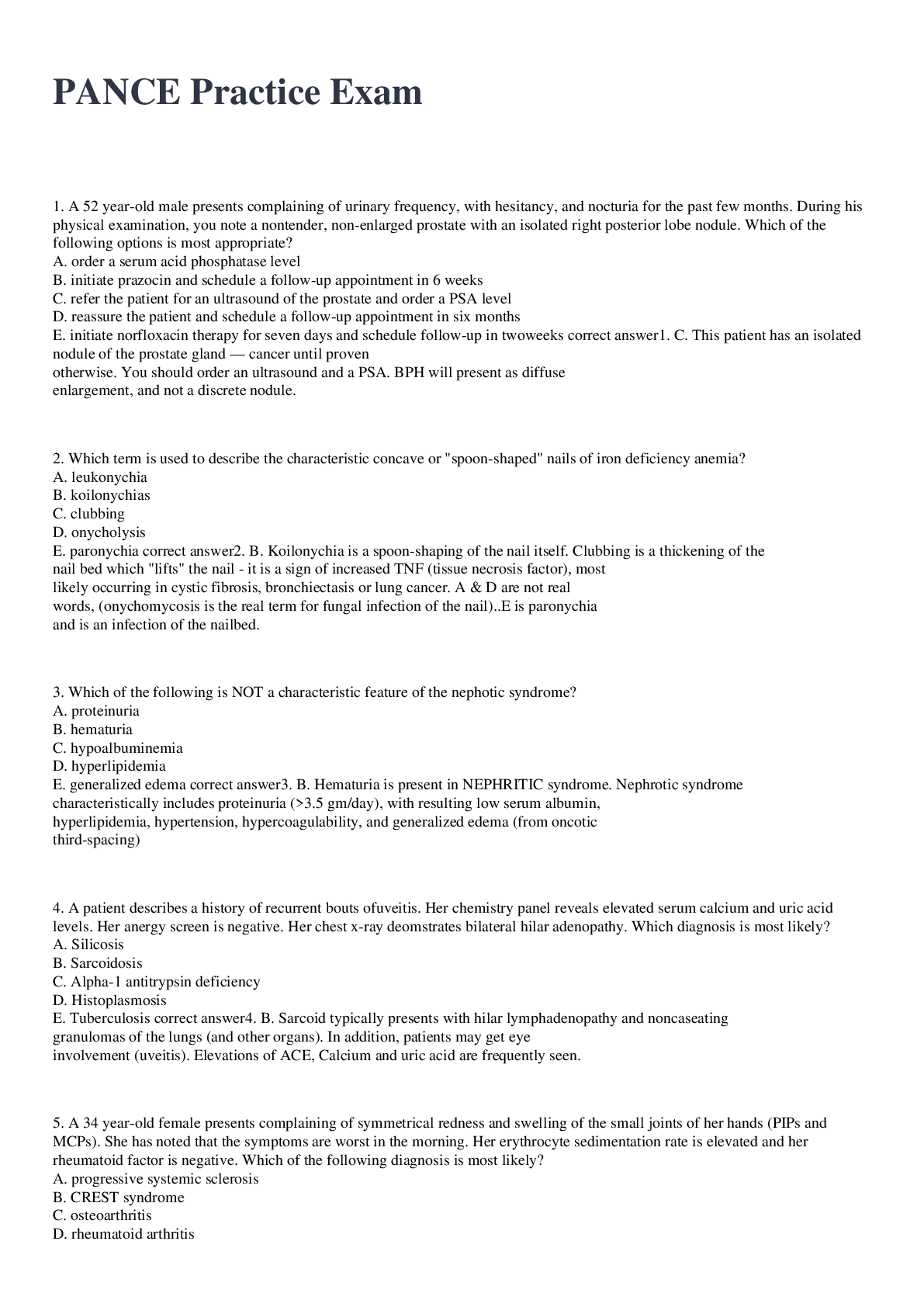
Buy this document to get the full access instantly
Instant Download Access after purchase
Add to cartInstant download
We Accept:

Also available in bundle (1)

PANCE EXAM BUNDLE,
ALL YOU NEED TO PASS THE PANCE EXAM, DOWNLOAD TO SCORE HIGH
By bundleHub Solution guider 1 year ago
$38
11
Reviews( 0 )
$13.00
Document information
Connected school, study & course
About the document
Uploaded On
Aug 20, 2022
Number of pages
80
Written in
Additional information
This document has been written for:
Uploaded
Aug 20, 2022
Downloads
0
Views
78






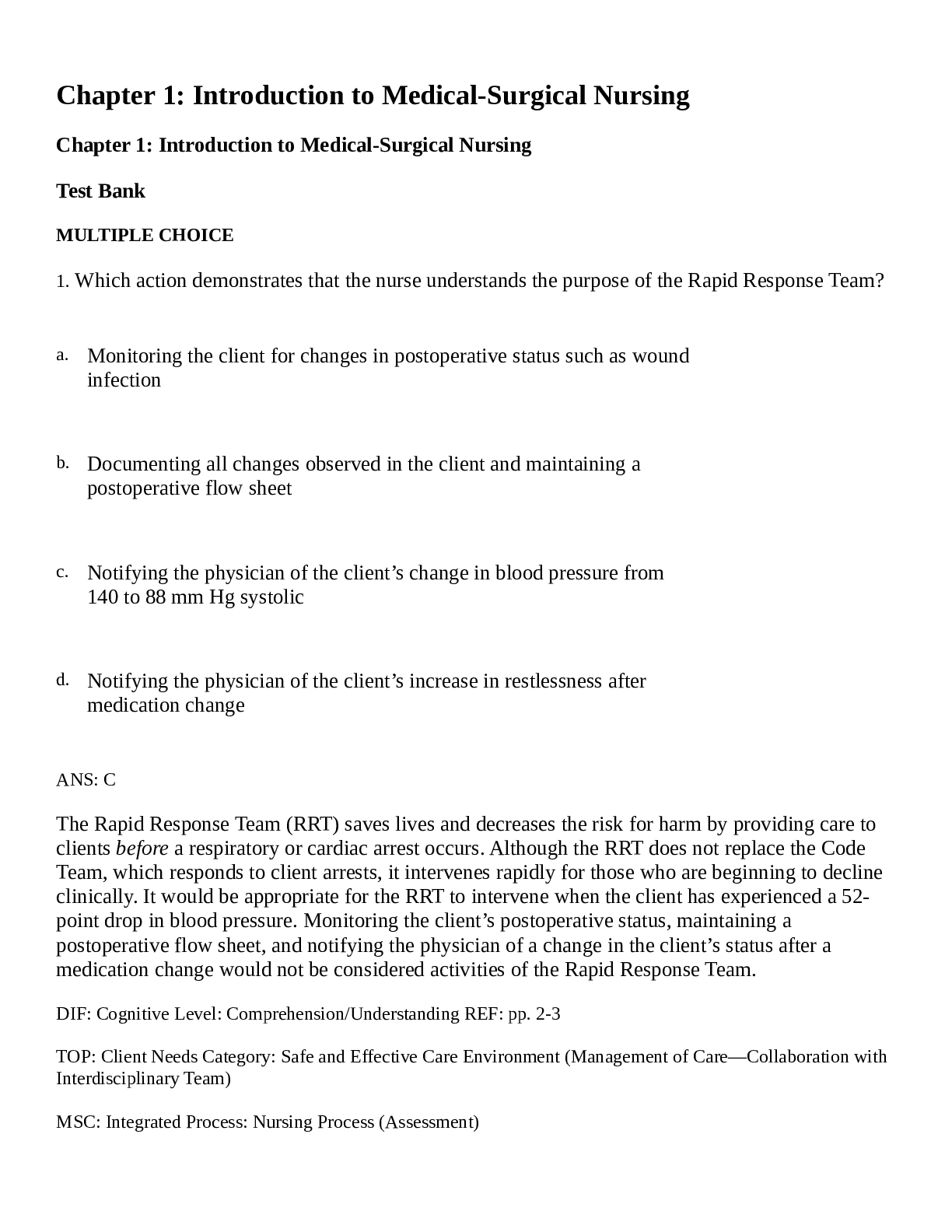


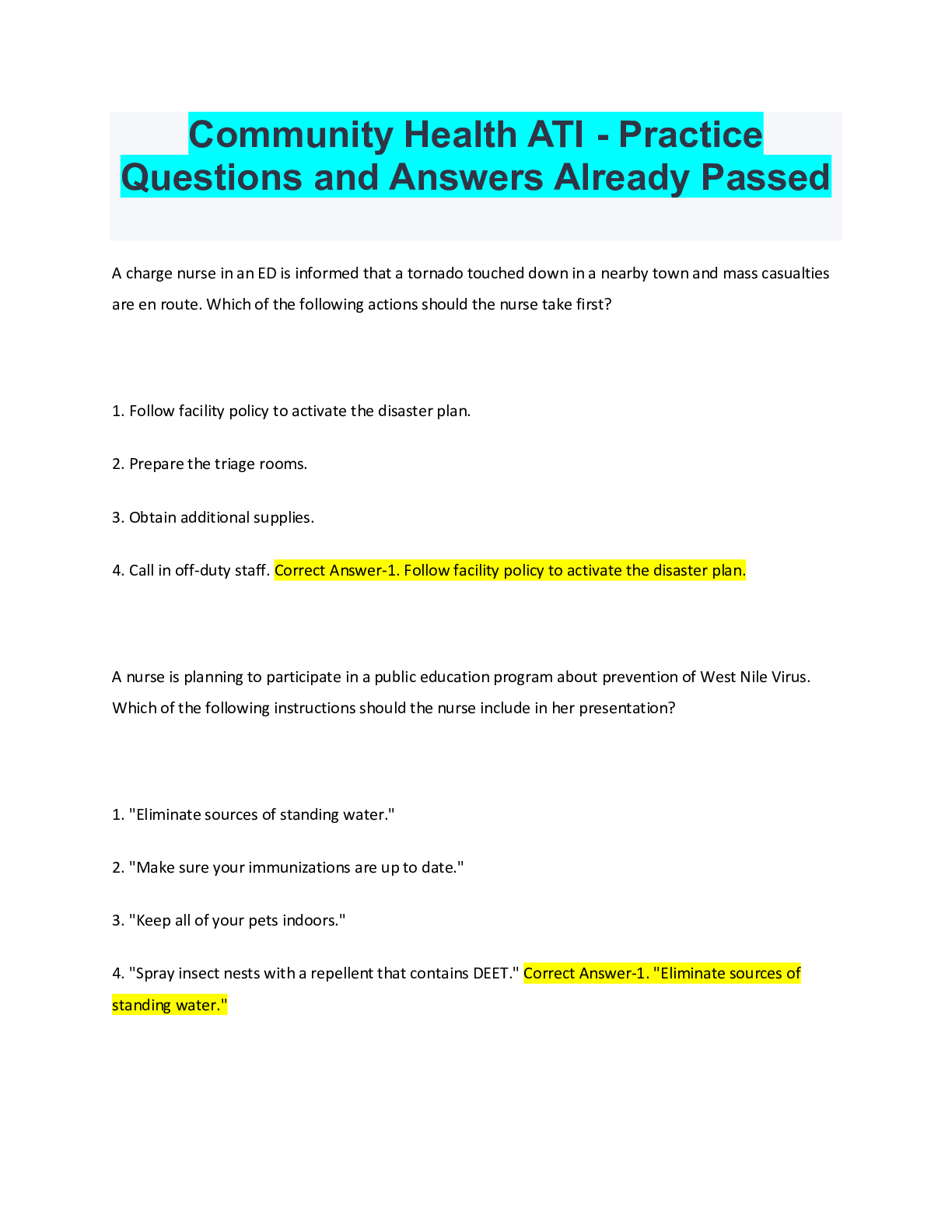
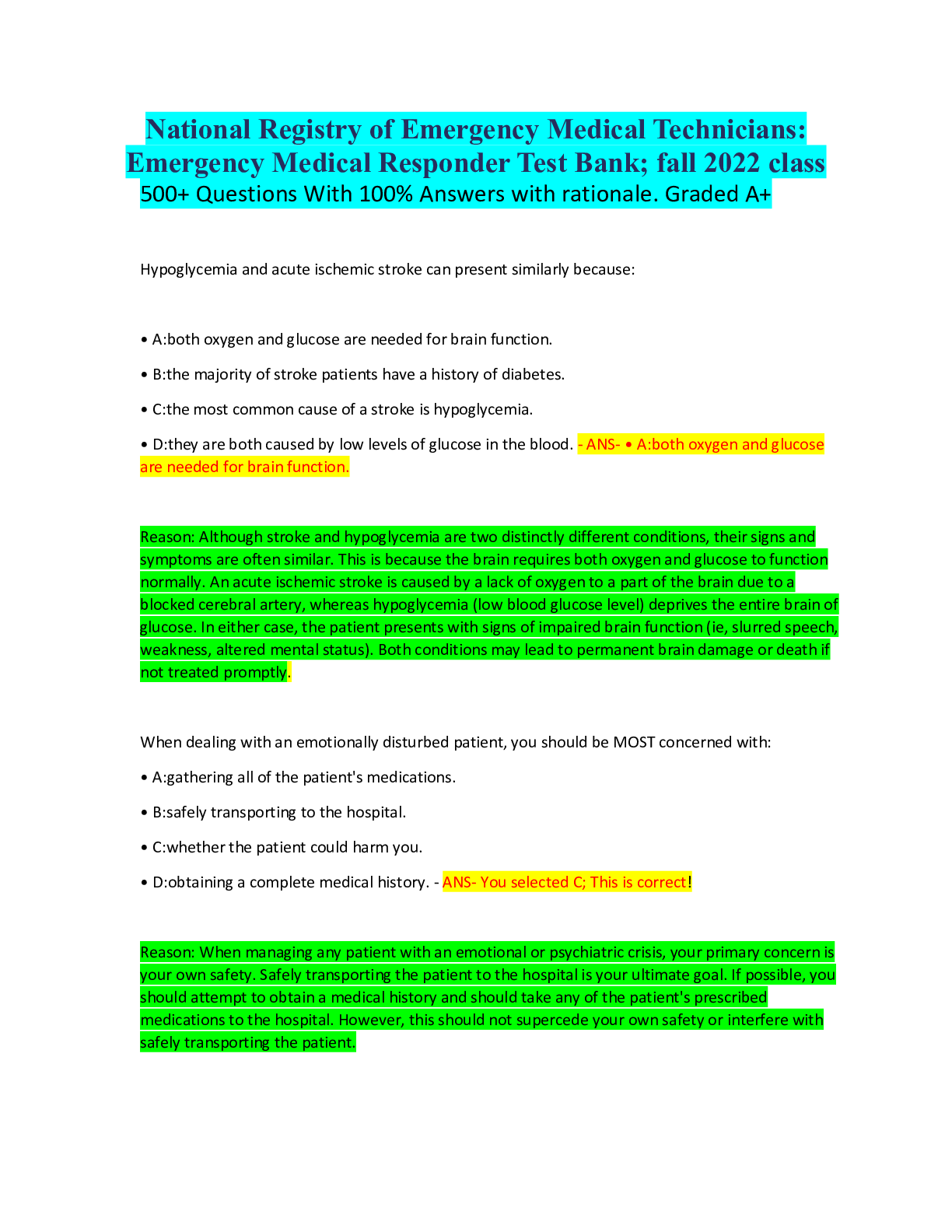

 (1).png)



